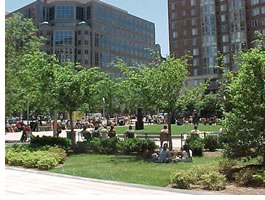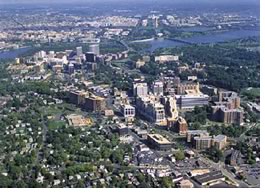
Category: Overall Excellence
Arlington's planning approach places dense, mixed-use, infill development at five Metro stations and tapers it down to residential neighborhoods. The result? More than 21 million square feet of office/retail/commercial space, 3000-plus hotel rooms, and 22,500 residential units creating vibrant "urban villages" where people live, shop, work, and play using transit, pedestrian walkways, bicycles, or cars.
 Arlington
County uses smart growth principles to generate residential, retail, and
recreational development around the Rosslyn-Ballston corridor of Metro
stations. The corridor includes five stations: Rosslyn, Court House, Clarendon,
Virginia Square, and Ballston. Arlington adopted a General Land Use Plan
(GLUP) to concentrate dense, mixed-use development at the stations and
developed sector plans to ensure that each maintained a distinct sense
of community. The county uses incentive zoning to attract private transit-oriented
development.
Arlington
County uses smart growth principles to generate residential, retail, and
recreational development around the Rosslyn-Ballston corridor of Metro
stations. The corridor includes five stations: Rosslyn, Court House, Clarendon,
Virginia Square, and Ballston. Arlington adopted a General Land Use Plan
(GLUP) to concentrate dense, mixed-use development at the stations and
developed sector plans to ensure that each maintained a distinct sense
of community. The county uses incentive zoning to attract private transit-oriented
development.
Each plan focuses growth within a walkable radius of stations and preserves established neighborhoods and natural areas. Arlington's urban villages emphasize pedestrian access and safety and incorporate public art, "pocket" parks, wide sidewalks with restaurant seating, bike lanes, street trees, traffic calming, and street-level retail. A site plan review links goals in the GLUP with details of each proposed project.
 Metro
station locations and the GLUP continue to guide development. Between
1999 and 2002, the corridor gained 2,500 apartments and condos, 1.5 million
square feet of office space, 379,000 square feet of retail space, and
five miles of bike lanes. The corridor is so popular that preserving affordable
housing is a challenge. In 2001, Arlington adopted an expanded bonus density
provision for development of affordable housing, allowing up to 25 percent
more density.
Metro
station locations and the GLUP continue to guide development. Between
1999 and 2002, the corridor gained 2,500 apartments and condos, 1.5 million
square feet of office space, 379,000 square feet of retail space, and
five miles of bike lanes. The corridor is so popular that preserving affordable
housing is a challenge. In 2001, Arlington adopted an expanded bonus density
provision for development of affordable housing, allowing up to 25 percent
more density.
The transit successes and corresponding environmental performance are impressive. Metro ridership doubled in the corridor between 1991 and 2002; nearly 50 percent of corridor residents use transit to commute. At the end of 2001, the corridor had more than 18 million square feet of office space, 3 million square feet of retail/commercial space, more than 3,000 hotel rooms, and 22,500 residential units—with many more under construction. Creating this development at typical suburban densities could have consumed over 14 square miles of open space compared to the roughly two square mile Rosslyn-Ballston corridor.
Copyright 2002 The American Institute of Architects. All rights reserved.
![]()
|
|
|